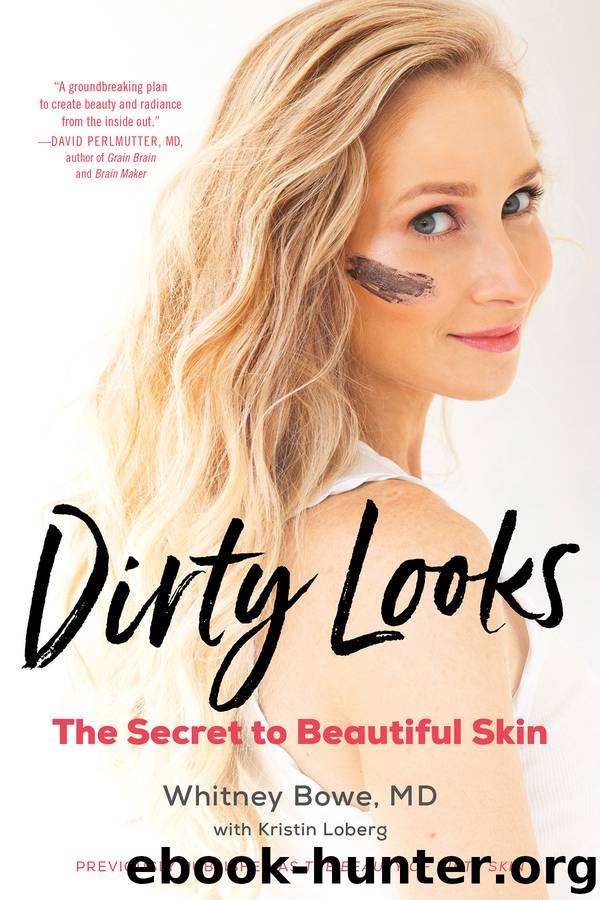Dirty Looks by Whitney Bowe

Author:Whitney Bowe
Language: eng
Format: epub
Publisher: Little, Brown and Company
Published: 2018-04-16T16:00:00+00:00
Admit it: at some point in your life, you bought food with the “fat-free” label on it. Perhaps you were trying to avoid fats altogether, thinking they were making you fat. Weight-loss companies, advertisers, grocery stores, food manufacturers, and popular books have long sold the idea that we should maintain a low-fat diet. Indeed, certain types of fat, such as commercially processed fats and oils (trans fats), are associated with adverse health outcomes. But not so for unmodified natural fats, whether from animals or plants.
We need dietary fat to survive. In fact fat is one of the most important elements in skin health. Each skin cell is surrounded by two layers of fat, which make up the cell’s membranes. Known as the phospholipid bilayer, they incorporate dietary fats into their membranes and are key to the appearance of plump, healthy skin. Here’s something else to consider: your skin’s surface houses fat-friendly bacteria. These microbes consume the oil found naturally on your skin, leaving behind a thin antimicrobial layer of beauty-boosting fatty acids. When you don’t incorporate enough fats in your diet, you starve these microbes, and they can’t protect you. You also starve your skin of the super-moisturizing lipids that it needs to get the Bowe Glow. And when you wash your skin with certain products, you wash the protective oils away, making your skin more susceptible to infection.
There is a particular type of fat that should be favored over others, though: omega-3 fatty acids, which are polyunsaturated fats. These are the essential fatty acids that have celebrity status in the dietary world.22 The two critical omega-3s are eicosapentaenoic acid (EPA) and docosahexaenoic acid (DHA), which are primarily found in fish. A third, alpha-linolenic acid (ALA), is found in nuts and seeds. We need these fatty acids to function, and their benefits—from helping reduce inflammation to promoting brain function, lowering bad blood fats, and, yes, helping skin’s appearance by controlling oil (sebum) production—are well documented. Omega-3s also help delay the skin’s aging process by nourishing those skin-cell membranes and keeping them fluid, thereby staving off wrinkles. In turn, this boosts hydration and prevents acne. The trouble is, most people don’t get enough omega-3s. Instead they’re loading up on too many proinflammatory omega-6s. Currently the general omega-6 to omega-3 intake ratio in America is twenty to one. The ideal ratio is two to one.
Omega-3s can also counter the effects of processed vegetable oils in our American diet. Unfortunately, the typical Western diet is extremely high in processed omega-6 fats, which are found in many commercial vegetable oils, including safflower oil, corn oil, canola oil, sunflower oil, and soybean oil: vegetable oil represents the number one source of fat in the American diet. We do need some omega-6 fats in our diet, but the focus should be on those found naturally in many nuts, seeds, avocados, and eggs. Alongside omega-3s, omega-6s are part of the building blocks of healthy cell membranes and are important not only because they help produce the skin’s
Download
This site does not store any files on its server. We only index and link to content provided by other sites. Please contact the content providers to delete copyright contents if any and email us, we'll remove relevant links or contents immediately.
When Breath Becomes Air by Paul Kalanithi(7276)
Why We Sleep: Unlocking the Power of Sleep and Dreams by Matthew Walker(5664)
Paper Towns by Green John(4179)
The Immortal Life of Henrietta Lacks by Rebecca Skloot(3834)
The Sports Rules Book by Human Kinetics(3597)
Dynamic Alignment Through Imagery by Eric Franklin(3502)
ACSM's Complete Guide to Fitness & Health by ACSM(3474)
Kaplan MCAT Organic Chemistry Review: Created for MCAT 2015 (Kaplan Test Prep) by Kaplan(3430)
Introduction to Kinesiology by Shirl J. Hoffman(3307)
Livewired by David Eagleman(3137)
The River of Consciousness by Oliver Sacks(2999)
Alchemy and Alchemists by C. J. S. Thompson(2918)
The Death of the Heart by Elizabeth Bowen(2910)
Descartes' Error by Antonio Damasio(2746)
Bad Pharma by Ben Goldacre(2737)
The Gene: An Intimate History by Siddhartha Mukherjee(2502)
Kaplan MCAT Behavioral Sciences Review: Created for MCAT 2015 (Kaplan Test Prep) by Kaplan(2495)
The Fate of Rome: Climate, Disease, and the End of an Empire (The Princeton History of the Ancient World) by Kyle Harper(2444)
The Emperor of All Maladies: A Biography of Cancer by Siddhartha Mukherjee(2440)
